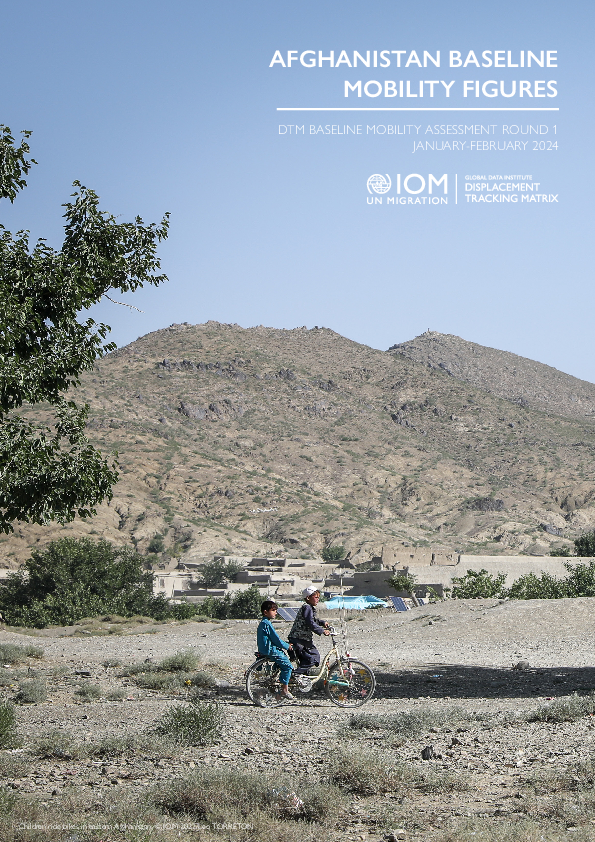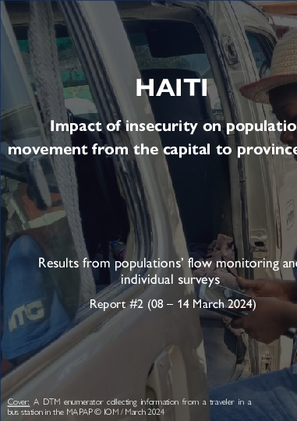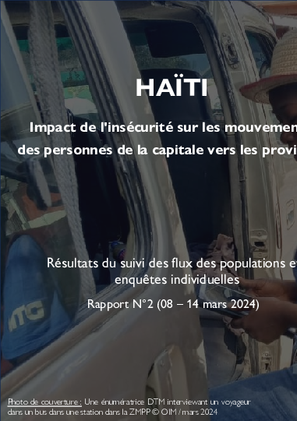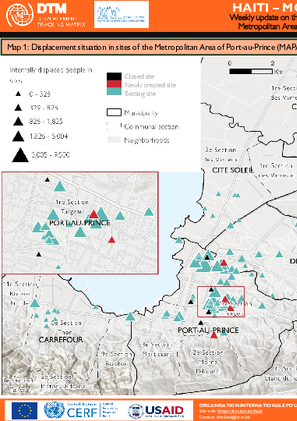-
Countries
-
Data and Analysis
-
Special Focus
-
Crisis Responses
Assessment Report

Contact
DTM Europe, DTMMediterranean@iom.int
Language
English
Location
Slovakia
Period Covered
Jan 01 2023
Dec 31 2023
Activity
- Survey
Key findings:
- 53 per cent of respondents live with people with specific needs or serious health conditions.
- Households living with people with specific needs* include infants aged 0-4 years old (15%), children aged 5-17 years old (46%), and elderly above 60 years old (44%).
- Specific needs* include chronic diseases or serious medical conditions (87%), visual impairment (70%) and hearing difficulties (19%).
- The need for additional information* on healthcare services is reported by 54 per cent of respondents, with 24 per cent citing the need for information on access to medication and one per cent in need of information on psychosocial support.
- Top barriers to accessing healthcare services* include long queues (58%), service costs (50%), unavailability (22%), language barrier (21%) and discrimination (17%).
- 94 per cent have applied for Temporary Protection among respondents facing barriers to access to healthcare.
- 76 per cent of respondents pay for healthcare services and/or medication.
(*more than one answer possible)

Contact
DTMAfghanistan@iom.int
Language
English
Location
Afghanistan
Period Covered
Jan 25 2024
Feb 29 2024
Activity
- Mobility Tracking
- Baseline Assessment
IOM Afghanistan launched the first round of the DTM Baseline Area Assessment B1 in January 2024 as part of its ongoing efforts to collect crucial data on population mobility dynamics, specifically displacement and returns. In particular, the B1 activity seeks to map the presence of mobile population groups, such as Internally Displaced Persons (IDPs), returnees, and internal migrants, to enable further understanding of conditions, vulnerabilities, and humanitarian needs through targeted data collection and analysis. After implementation of the B1, a subsequent assessment, the Baseline Village Assessment B2, will target all locations that report presence of mobile population groups to verify the results of the B1 and collect more granular information on reasons for mobility, shelter types, and places of origin.
The following report covers data collected for the B1 in January and February 2024, during which the IOM DTM Afghanistan team was able to completely cover two thirds (23 out of 34) of the provinces in the country. Further data collection to cover the remaining provinces is anticipated in the coming days. For a provisional look at baseline mobility figures for all 34 provinces, see the annex on pages 9 and 10, which combines the current B1 data with data collected during previous DTM activities.

Contact
DTM Haiti, dtmhaiti@iom.int
Language
English
Location
Haiti
Period Covered
Mar 08 2024
Mar 14 2024
Activity
- Survey
- Flow Monitoring Survey
- Flow Monitoring
Since 29 February 2024, several neighborhoods in the Metropolitan Area of Port-au-Prince (MAPAP), the capital of Haiti, have been targeted by increased armed attacks. Nearly 15,000 people were displaced following these attacks (see ETT 39.1). In addition to creating displacement within the MAPAP, attacks and generalized insecurity are pushing more and more people to leave the capital to find refuge in provinces, taking the risks of passing through gangs-controlled routes. In order to monitor these movements towards provinces and inform appropriate response strategies, DTM has launched data collection at several of the most used bus stations in the capital (see page 5 for more details on the methodology). Since the start of this activity, on 8 March, until 14 March, this activity allowed to observe the movements of 16,947 people leaving the MAPAP (see pages 3 and 4 for more details on the profile of these people ). The majority of them (60%) took means of transport heading towards the Grand Sud departments (Grande’Anse, South, Nippes and South-East). It should be noted that this region already hosts more than 116,000 people who had in vast majority, fled the MAPAP in recent months (see the report on displacement in the Grand Sud).
Individual interviews with a sample indicated that 83% of people left the MAPAP because of violence and insecurity. 76% were already internally displaced before leaving the MAPAP. 96% intend to stay in the provinces in Haiti, 3% to leave for the Dominican Republic and less than 1% for the United States and Brazil.

Contact
DTM Haiti, dtmhaiti@iom.int
Language
French
Location
Haiti
Period Covered
Mar 08 2024
Mar 14 2024
Activity
- Survey
- Flow Monitoring Survey
- Flow Monitoring
Depuis le 29 février 2024, plusieurs quartiers de la Zone Métropolitaine de Port-au-Prince (ZMPP), la capitale d’Haïti, sont ciblés par des attaques armées accrues. Près de 15 000 personnes se sont déplacées suite à ces attaques (voir le ETT 39.1). En plus de créer des déplacements à l’intérieur de la ZMPP, ces attaques poussent de plus en plus de personnes à quitter la capitale pour trouver refuge dans les provinces, en prenant les risques de passer par des routes contrôlées par des gangs. Afin de suivre ces mouvements vers les provinces et informer les stratégies de réponse adéquates, la DTM a lancé des collectes de données au niveau de plusieurs stations de bus les plus utilisées dans la capitale (voir la page 4 pour plus de détails sur la méthodologie). Depuis le début de cette activité, le 08 mars, jusqu’au 14 mars, cette activité a permis d’observer les mouvements de16 947 personnes quittant la ZMPP (voir les pages 3 et 4 pour plus de détails sur le profil de ces personnes). Ces personnes ont en majorité (60%) pris des moyens de transport se dirigeant vers les départements du Grand Sud (Grande’Anse, Sud, Nippes et Sud-Est). Il est à souligner que cette région accueille déjà plus 116 000 personnes qui avaient en grande partie fui la ZMPP durant des mois passés (voir le rapport sur les déplacements dans le Grand Sud).
Les interviews individuelles avec un échantillon ont indiqué que 83% des personnes quittaient la ZMPP à cause des violences et l'insécurité. 76% étaient déjà déplacées internes avant de quitter la ZMPP. 96% ont l'intention de rester dans les provinces en Haïti, 3% de partir vers la République Dominicaine et moins de 1% vers les Etats-Unis et le Brésil

Contact
DTM Haiti, dtmhaiti@iom.int
Language
English
Location
Haiti
Period Covered
Mar 09 2024
Mar 15 2024
Activity
- Mobility Tracking
- Site Assessment
- Baseline Assessment
To continually inform humanitarian responses in the MAPAP sites, the CCCM cluster and DTM conduct weekly data collections in these sites to update information on the displacement situation in the sites.
This report presents the situation as of 15 March 2024. A total of 84 sites are active in the MAPAP hosting 86,040 IDPs, this represents 12% less compared to the previous week.

Contact
dtmlebanon@iom.int
Language
English
Location
Lebanon
Period Covered
Oct 10 2023
Mar 14 2024
Activity
- Mobility Tracking
- Baseline Assessment
Since October 8 there has been an increase in cross-border incidents between Israel and Lebanon, resulting in the displacement of people both within the South and elsewhere within the country. Since October 10, the Displacement Tracking Matrix (DTM) has been conducting the daily monitoring of population movements. The objective of the exercise is to inform preparedness and response planning.

Contact
DTMUkraine@iom.int
Language
English
Location
Ukraine
Snapshot Date
Mar 14 2024
Activity
- Survey
The General Population Survey is a highly representative assessment with 20,000 random respondents interviewed, providing population data and enabling an assessment of the geographic distribution of the war-affected populations across the country.
Over the course of March 2022 to January 2023, the IOM’s Data and Analytics successfully carried out 12 rounds of the General Population Survey. Initially conducted bi-monthly and later transitioning to a monthly frequency, the results were extrapolated at both national and macro-regional levels. As of May 2023, the survey methodology underwent adaptation to generate quarterly representative data at the oblast level, thus facilitating localized analysis.

Contact
DTM Mozambique, DTMMozambique@iom.int
Language
English
Location
Mozambique
Period Covered
Jul 01 2023
Jul 31 2023
Activity
- Mobility Tracking
- Site Assessment
This Multi-Sectorial Location Assessment (MSLA) report, which presents findings from the International Organization for Migration’s (IOM) Displacement Tracking Matrix (DTM) Round 12 assessments, aims to enhance understanding of the extent of internal displacements and the needs of affected populations in conflict-affected and disaster-affected districts of Mozambique. Data was collected between 12 - 30 July 2023 in close coordination with provincial government and Instituto Nacional de Gestão e Redução do Risco de Desastres (INGD) partners, and presents trends from 191 assessed sites hosting internally displaced persons across Northern (Cabo Delgado 94 sites, Nampula 2 sites, Niassa 7 sites) and Central Mozambique (Manica 35 sites, Sofala 36 sites, Tete 4 sites, Zambezia 13 sites).
In total, 392,598 internally displaced persons (IDPs). This is much higher than MSLA Round 11, as all sites in Northern and Central Mozambique are now being analysed jointly. Reported figures, however, exclude displaced individuals living in host community settings. According to DTM Round 19 Mobility Tracking Report, as of August, an estimated 850,599 were identified living in both host communities and sites (668,939 IDPs in Northern Mozambique, and 181,660 IDPs in Central Mozambique).

Contact
DTM Europe, DTMMediterranean@iom.int
Language
English
Location
Serbia
Period Covered
Jun 20 2023
Aug 31 2023
Activity
- Survey
- Flow Monitoring
This report presents the results of the third round of the Displacement Tracking Matrix (DTM) Flow Monitoring Surveys (FMS) implemented in Serbia. FMS provides a snapshot of the profiles, experiences and needs of migrants residing in reception centres in Serbia. The data was collected from 20 June to 31 August 2023 in the reception centre in Preševo, in the southern region bordering North Macedonia, and in asylum centres of Obrenovac and Krnjača, close to the capital city of Belgrade. IOM, in partnership with the Commissariat for Refugees and Migration of the Republic of Serbia (known by its Serbian acronym as KIRS), interviewed a total of 208 individual respondents.

Contact
DTM Support, DTMSupport@iom.int
Language
English
Location
Mozambique
Period Covered
Mar 01 2024
Mar 12 2024
Activity
- Survey
- Return Intention
IOM’s Displacement Tracking Matrix in collaboration with INGD conducted a movement intention survey to 1,062 household hosting 5,010 individuals displaced from Chiure district in Cabo Delgado to Erati district in Nampula province. Conflict and/or fear of attacks due to Non-State Armed Groups (NSAGs) in Cabo Delgado was the main trigger of displacement. 95% were displaced from Ocua posto. 52% of the IDPs are female whilst 48% are males. Children consitutes 55% of the IDPs.
The objective of the assessment was to better understand the conditions of the IDP households in the current place of displacement and their short term intentions. 98% of the displaced households arrived in the current locations between 19 and 24 February 2024. 84% intend to stay in the current location for a period longer than one week.
Pagination
- Previous page
- Page 44
- Next page
